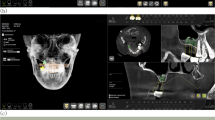Abstract
Acquiring reliable digital data from patient oral cavity is one of the keys to obtaining a precise outcome following virtual implant planning. For that means, clinicians need 2 types of data: virtual jaw replicas, delivered as surface scans, and medical images from hard and soft tissue anatomies. On one side, knowledge of bone topography and soft tissue thickness is undoubtedly necessary when planning implant surgery. Moreover, to improve diagnosis, CBCT studies can be imported into a computer to customize parameters such as: brightness, contrast, distance between slices and panoramic curve. Therefore, a universal medical language has been established to facilitate communication and image sharing processes: the DICOM file. On the other side, implant surgery should also be driven by a prosthetic plan. For that means, information from patient jaws is needed to set up said plan and fabricate a template to reproduce it. This information should come from virtual replicas of the oral cavity and not from CBCT images, as surface definition of tooth and mucosa tends to be poor in these studies; especially at the occlusal level. Moreover, metal restorations can cause great distortion over medical images whenever present in the oral cavity. Thus, surface scans obtained from optical scanners delivered as STL files, help overcome this issue. Correct merging of these two digital files (DICOM and STL) is another key factor to obtaining a precise outcome following virtual implant planning.






















Similar content being viewed by others
Further reading
Galante JM, Rubio NA (eds) Digital dental implantology. Comput Assist Imaging. https://doi.org/10.1007/978-3-030-65947-9_1
Alghazzawi TF (2016) Advancements in CAD/CAM technology: options for practical implementation. J Prosthodont Res 60(2):72–84
Richert R, Goujat A, Venet L, Viguie G, Viennot S, Robinson P, Farges JC, Fages M, Ducret M (2017) Intraoral scanner technologies: a review to make a successful impression. J Healthc Eng 2017:8427595
Al-Hassimy H, Al-Hassimy H, Al-Hassimy A (2019) Review of the intraoral scanners at IDS. Institute of Digital Dentistry, Cologne
Revilla-León M, Jiang P, Sadeghpour M, Piedra-Cascón W, Zandinejad A, Özcan M, Krishnamurthy VR (2020) Intraoral digital scans: part 2-influence of ambient scanning light conditions on the mesh quality of different intraoral scanners. J Prosthet Dent. 124(5):575–580
Galucci G, Evans C, Tahmseb A (2019) ITI treatment guide, vol 11. Quintessence Publishing, Berlin
Grant GT, Campbell SD, Masri RM, Andersen MR (American College of Prosthodontists Digital Dentistry Glossary Development Task Force) (2021) Glossary of Digital Dental Terms, 2nd Edition: American College of Prosthodontists and ACP Education Foundation. J Prosthodont 30(S3):172–181. https://doi.org/10.1111/jopr.13439
Ferro KJ, Driscoll CF, Freilich MA, Guckes AD, Knoernschild KL, McGarry TJ (Glossary of Prosthodontic Terms Committee)(2017) The glossary of prosthodontic terms: ninth edition. J Prosthet Dent 117(5S):e1–e105. https://doi.org/10.1016/j.prosdent.2016.12.001
Berkhout WE (2015) Het ALARA-principe. Achtergronden en toepassing in de praktijk [The ALARA-principle. Backgrounds and enforcement in dental practices]. Ned Tijdschr Tandheelkd 122(5):263–270. https://doi.org/10.5177/ntvt.2015.5.14227
Jaju PP, Jaju SP (2015) Cone-beam computed tomography: time to move from ALARA to ALADA. Imaging Sci Dent 45(4):263–265. https://doi.org/10.5624/isd.2015.45.4.263
Author information
Authors and Affiliations
Corresponding author
Additional information
Publisher's Note
Springer Nature remains neutral with regard to jurisdictional claims in published maps and institutional affiliations.
Rights and permissions
About this article
Cite this article
Rubio, N.A. Computer-assisted imaging for virtual implant planning. Clin Dent Rev 6, 4 (2022). https://doi.org/10.1007/s41894-022-00118-5
Received:
Accepted:
Published:
DOI: https://doi.org/10.1007/s41894-022-00118-5




